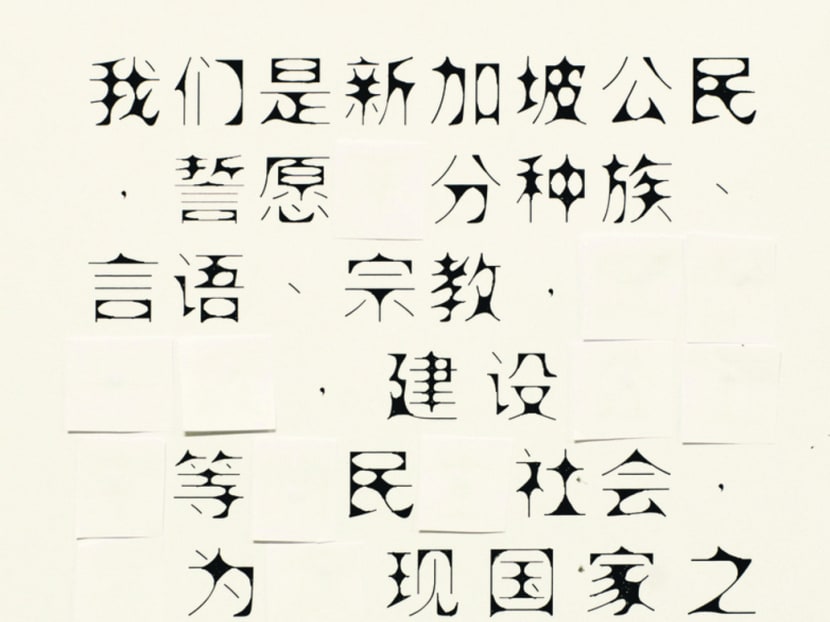Art review: Vernacula_
SINGAPORE — The 50th anniversary of the Republic continues to serve as a lightning rod for artists, curators and institutions alike to reflect, meditate and speculate about our past, present and future. As its title suggests, the ongoing Vernacula_ exhibition at the Nanyang Academy of Fine Arts focuses on the vernacular, suggesting a concern with the voices and stories of the common folk, and the tensions and parallels between them and official histories and narratives.



SINGAPORE — The 50th anniversary of the Republic continues to serve as a lightning rod for artists, curators and institutions alike to reflect, meditate and speculate about our past, present and future. As its title suggests, the ongoing Vernacula_ exhibition at the Nanyang Academy of Fine Arts focuses on the vernacular, suggesting a concern with the voices and stories of the common folk, and the tensions and parallels between them and official histories and narratives.
Which isn’t to say it’s all misty-eyed nostalgia for simpler times, romanticising the spirit of kampung living and HDB void decks. It’s a sprawling show, spread across a number of components: A contemporary art exhibition, a salon-style photography exhibition and a colossal stop-motion photographic time-lapse. Capping it off are a number of vitrines showcasing typical everyday possessions of various historical archetypes of the decades: The pioneering worker of the ’70s, a student of the ’80s and so on. Though not devoid of interest, this last element comes across as the stuff of endlessly-shared list-based clickbait articles with titles such as Things Only ’90s Kids Will Remember.
That aside, Vernacula_ has its share of gems, such as Urich Lau’s The Orators: Monologues. It presents on three monitors iconic monologues from the movies The Great Dictator, Citizen Kane and Dr Strangelove. All are stripped of their audio, with subtitles in Mandarin and English. The monologues, however, aren’t those of the original films. Instead, each of the three characters are variously re-cast as a critic, curator and museum director, commenting in their various capacities on art issues.
Depending on your familiarity with the films, you might experience a jarring sense of uncertainty about your memory, as if some sort of alternate universe was leaking through — though even without this sense of dislocation, there’s some humour to be found in imagining these larger-than-life personalities in their art world roles.
This interest in language and the vernacular is also found in works by Dzaki Safaruan and Winnie Tan. The former features phonetic transcriptions (in Arabic) of the lyrics of popular music, done in a format usually associated with religious texts hung in Muslim homes. As a link of sorts between the mundane and the sacred — the public adulation of musicians and one’s private religious convictions — one’s interpretation of Dzaki’s Home would seem a highly changeable and subjective matter.
Similarly, Winnie Tan’s The Pledge is a partially redacted transcription of our national pledge in Mandarin, with some key characters omitted. These omissions result in a certain amount of grammatical ambiguity, possessing the capacity to subvert the intended meaning of the original pledge — black humour in a political vein. At the same time, the conspicuous blank spaces of the missing characters enjoin some effort of memory in recalling the appropriate characters to be found in the original text, suggesting a tension between the pledge’s unsullied ideals and the complex realities of translating those ideals into tangible results.
Of course, there are more than just meditations on language on show in Vernacula_, with dozens of works by both relative newcomers and well-established names in the art scene working in a wide range of media, and each with their own concerns and perspectives. Perhaps this difficulty in generalising Vernacula_ as a bustling marketplace of ideas is a strength of a sort, a counterpoint to the cleanly delineated narratives of the official histories. Bruce Quek
Vernacula_ runs until May 19, 11am to 7pm, NAFA Campus 1, Galleries 1 and 2. Free admission. Closed on Mondays and public holidays.








